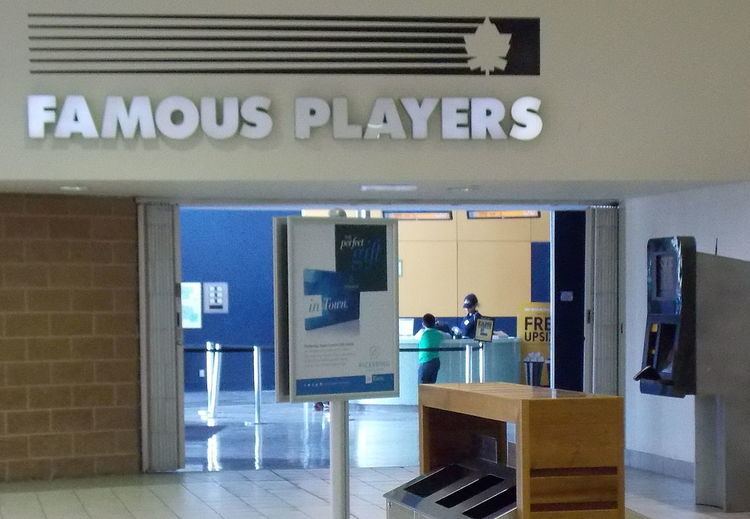Former type Private | Successors Cineplex Galaxy LP Founded 1920 Ceased operations 2005 | |
 | ||
Industry Film exhibitorBowling alleysCable Television Predecessors Famous Players Film Company Founder Nathan Nathanson(founder of earliest ancestor circuit) Predecessor Famous Players Film Company Parent organizations Viacom, Cineplex Entertainment LP | ||
Famous Players was a Canadian-based film exhibitor and cable television service provider; it operated numerous Canadian movie theatre locations stretching from British Columbia to Newfoundland and Labrador. The company was owned by Viacom Canada but was sold to Onex Corporation-owned Cineplex Galaxy LP in 2005.
Contents
History
Famous Players Canadian Corporation dates back to the early days of Famous Players Film Company (later Paramount Pictures), founded in 1912, as its earliest predecessor, though that company did not have any operations in Canada until 1920, when it bought Nathan Nathanson's Paramount Theatre chain, which Nathanson had established four years earlier. Nathanson, along with being the 5th richest person in the world, became the first president of the resulting entity, Famous Players Canadian Corporation. In 1923, Famous Players bought out rival Allen Theatres, acquiring many buildings in the process . The Famous Players Theatres chain was always strongly linked with Paramount, and was a wholly owned subsidiary of Paramount Communications at the time that firm was acquired by Viacom in 1994. Some of the most high-profile and popular theatres in the Famous Players chain were the Imperial and the Uptown in Toronto; and the Capitol, Orpheum, Stanley, and Strand in Vancouver.
Originally began with 13 theatres located in Ontario and British Columbia, the company quickly expanded its holdings to 100 by the end of 1926. Until the 1950s, the company continued to build its operations in the movie theatre sector.
In 1952, however, Famous Players began to invest in the new technology. First, the company purchased the rights to a coinbox system that connected to television sets. A year later, it purchased its first broadcasting assets, CKCO-TV in Kitchener, Ontario and CFCM-TV in Québec City.
At the end of the 1950s, the company acquired the first of many cable TV companies it would come to own, thus adding control over the distribution of its TV product. As the industry grew, starting in the mid-1960s, so did the assets of Famous Players in this segment. In 1971, the company sold off the majority of its shareholdings in its movie theatre and other non-TV-related entertainment holdings to Gulf + Western Canada and subsequently changed its name to Canadian Cablesystems Limited, reflecting the new focus of its operations. Canadian Cablesystems was the owner and operator of Metro Cable, which served parts of Metro Toronto, as well as a minority shareholder in several other cable companies, until it was purchased by Rogers Cablesystems Ltd. (founded by Ted Rogers) in 1978.
Most famously, Famous Players Theatres allowed the lease on a property containing the entrance of one of its flagship Toronto locations, the Imperial Six, to lapse in 1986. Cineplex immediately took over the lease, denying Famous Players Theatres access to the portion of the property that they already owned outright. Famous Players eventually sold its property to Cineplex Odeon Cinemas, on the condition it never again be used to show filmed entertainment. Cineplex's live-theatre division renovated the theatre; renamed the Pantages Theatre, it hosted The Phantom of the Opera for ten years. The theatre was renamed the Canon in 2001 and then again in 2011 as the Ed Mirvish Theatre, which it is currently known, in honour of the popular businessman and ironically Mr. Drabinsky's main competitor in live theatre in Toronto.
Famous Players expanded throughout the 1990s. Under chairman John Bailey, Famous Players re-built its infrastructure from 1997 to 2003 with new "megaplex" theatre brands featuring stadium seating, such as SilverCity and Coliseum, with food courts and video games. Around that time, AMC Theatres entered the Canadian market, and most of the traditional ties between the existing chains and the major studios began to unwind, putting all three chains in full-on competition in several major markets.
The company once operated a number of drive-in theatres, but most have been closed and replaced with modern theatres. Until 2004, it operated theatres in the Maritimes, none of which were branded-concept theatres; these were sold to the region's dominant exhibitor, Empire Theatres.
In June 2005, Viacom announced it would sell Famous Players to Cineplex Galaxy, controlled by Onex Corporation for $500 million (about US$397 million). This deal was completed on July 22, 2005. To satisfy antitrust concerns, on August 22, 2005 the group announced the sale of 27 locations in Ontario and western Canada to Empire Theatres.
Theatres
Prior to merging with Cineplex, Famous Players operated five theatre brands: Famous Players, SilverCity, Coliseum, Colossus and Paramount. Of these, Cineplex only preserved the first two brands. The Coliseum and Colossus theatres sold to Cineplex were renamed to Cineplex Cinemas, though the unique features of the original brands were preserved. Similarly, Paramount theatres now use the Scotiabank Theatre brand since 2007.
